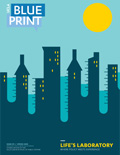CAN — INDEED, SHOULD — ACADEMIC RESEARCH inform public debate and guide public policy? Of course. But the question is not so simple. Some research may pursue truth for the sake of truth; its effect on the public, much less policy, will be remote or even non- existent. Nonetheless, it might enlighten and enrich. Other research may bear directly on public policy, but it might be driven by politics or self-interest in ways that disqualify it from academic merit.
The effect of academic research on debate and policy is a priority at UCLA’s Luskin School of Public Affairs. Its dean, Gary Segura, sits close to the pinnacle of the intersection of academia and the public world. This focus is reinforced by his latest work. He is the co-author of Costly Calculations, a searching, book-length exploration into the most consequential of public decisions — whether, under what circumstances and for how long to wage war.
Segura and I spoke this spring about the role of policy research and public affairs, and specifically about his book, the full title of which is Costly Calculations: A Theory of War, Casualties, and Politics. (Note: Blueprint magazine is embedded at Luskin, making Segura akin to our publisher. Consider this a look inside one of our staff meetings.)
Policy research, Segura said, “lays out evaluation criteria by which policies can be judged” and “explains how policy objectives came to be the way they are.”
It elevates the study of a policy beyond the metrics that politicians typically assign to it — such as its popularity or its impact upon certain interest groups. To take war as the gravest of examples, a politician might be inclined to favor the use of military force because the defense industry wants it, or because constituents favor it. The former would be crassly cynical, the latter more complicated. Responding to popular will is not the worst thing for a democratically elected leader to do, but how should a responsible politician evaluate the public’s will and take into account nuances such as the differing reactions among people depending on their backgrounds or their shifting reactions over time?
Those are some of the issues at the heart of Costly Calculations, the result of a 25-year collaboration between Segura and co-author Scott Sigmund Gartner, provost at the U.S. Naval Postgraduate School in Monterey.
The two “cooked up the idea,” as Segura put it, when they were both young professors at UC Davis in the fall of 1991. Their initial interest was the relationship between casualties and public support for war. They asked the question: Do rising casualties cause the public to sour on a war? The answer, they discovered, was not always, and not in the ways one might expect. Neither “hawks,” nor “doves,” for instance, are much moved by casualties, since their views of a conflict already are fairly locked in.
That leaves swings in public opinion up to what the authors call “ evaluators.” But even among them, opinion does not move in lock-step with rising death counts. Especially in the early stages of a war, support often increases even as the first Americans are killed; and over time, public opinion may treat casualties differently depending on other factors, such as the urgency of a conflict. Support may hold up in a contest for survival, while it might wane if the stakes seem lower. The war against Hitler’s Germany and the U.S. invasion of Grenada in 1983 do not evoke the same level of urgency.
Equally groundbreaking is the book’s analysis of how information affects the public and leadership differently. Segura noted, for instance, the sharp difference in the lessons that the American public and its military leadership derived from the Vietnamese Tet Offensive in 1968. The incongruity reflected the information those groups received and the expectations against which they considered it.
The military was accustomed to considering comparative casualties, and Tet represented a staggering disparity: North Vietnam and the Viet Cong lost some 33,000 soldiers in the first two weeks, roughly 10 times the losses inflicted upon the United States and its South Vietnamese ally. To the Pentagon, that made Tet an American victory. But the American public, assured for years that the war was nearing a successful conclusion, focused on American and South Vietnamese lives lost — 3,470 allied soldiers, about one third of them Americans. That reinforced fears that the war had entered what respected CBS News anchor Walter Cronkite memorably described as a “stalemate.” In political terms, Tet was an American failure.
Costly Calculations presents these findings with the cool neutrality of an academic study. And yet, its lessons are unmistakable: They are a reminder that the public is neither uniform nor stuck in time, that not all wars are the same, and that no war can be won without the support of the electorate, whatever form that takes.
Those are sound bases for evaluating the advisability and sustainability of war. They also demonstrate academic scholarship at the heart of public policy — and thus, at the heart of Blueprint.























